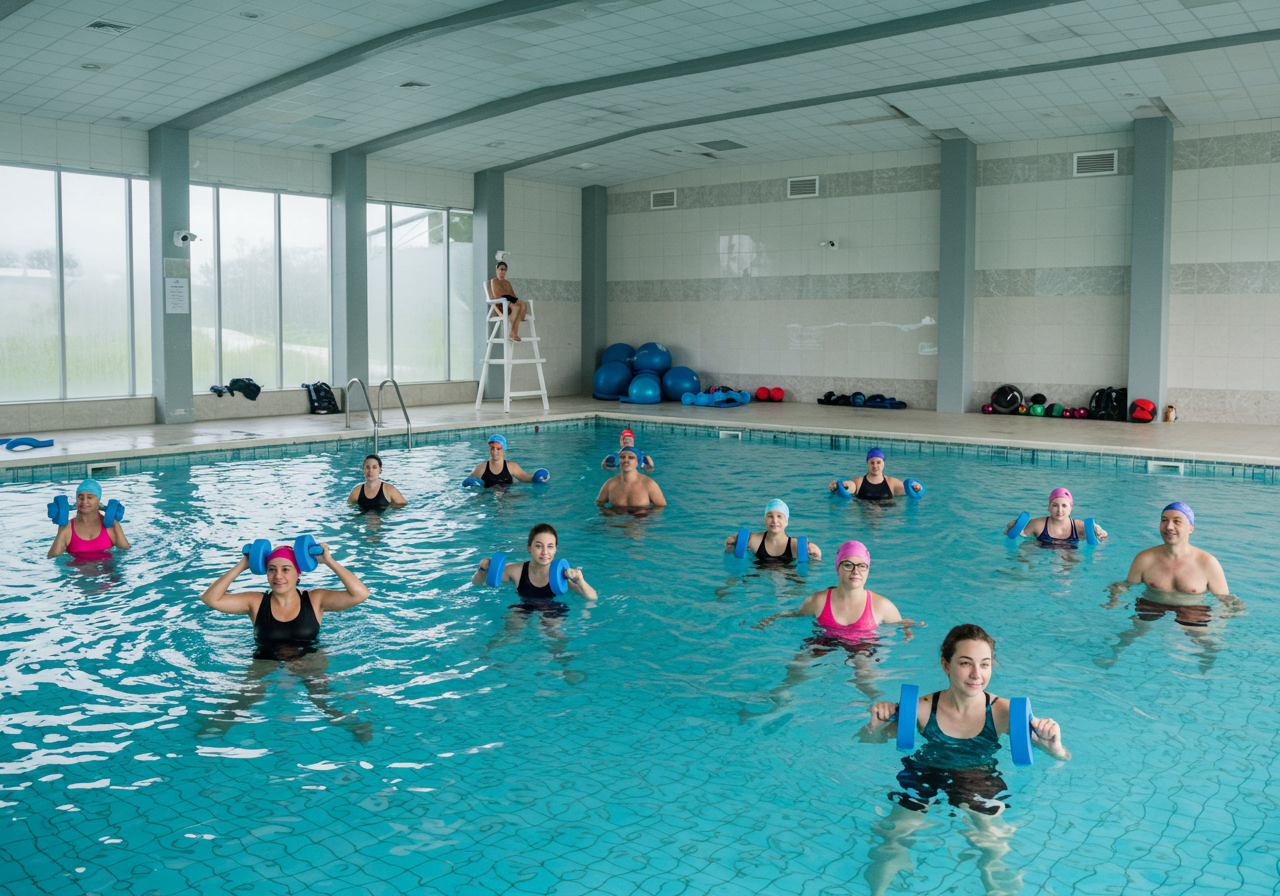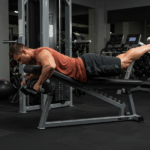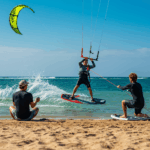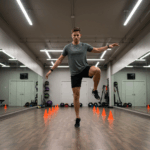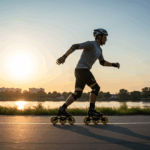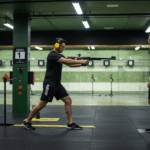Water Cardio Blueprint: Safe Starts and Smart Structure

Water Cardio Blueprint: Safe Starts and Smart Structure
This blueprint gives beginners a clear start. It also scales to athletes.
Water reduces joint stress. However, it still challenges your heart and lungs.
I coach new swimmers weekly. I use these simple rules to build fitness safely.
- Start with shallow water for control and safety.
- Keep ribs down, core braced, and eyes forward.
- Use Rate of Perceived Exertion, or RPE, to guide effort.
- Lower heart rate targets about 10–15 bpm in water.
- Train three to five days weekly for steady gains.
Use a simple weekly structure. Keep one easy day after every hard day.
| Day | Session | Duration | Intensity | Focus |
|---|---|---|---|---|
| Mon | Aqua walk + light jog | 25–35 min | Zone 1–2, RPE 3–4 | Aerobic base |
| Wed | Intervals with aqua belts | 30–40 min | Zone 3–4, RPE 6–8 | Lactate threshold |
| Fri | Steady aqua aerobics class | 35–45 min | Zone 2, RPE 4–5 | Endurance |
| Sat | Technique + mobility | 20–30 min | Easy, RPE 2–3 | Skill and recovery |
Water heart rate runs lower. Use RPE to confirm effort.
I track heart rate with a Garmin device. I log food with MyFitnessPal to support goals.
Garmin helps me review zones. MyFitnessPal helps me balance calories.
Level-Up Progressions: From First Splash to Strong Strides

Level-Up Progressions: From First Splash to Strong Strides
Progress slowly for better results. Add time, density, or drag each week.
Use these level plans. Move up when you complete all minutes comfortably.
| Level | Session Plan | Intensity | Notes |
|---|---|---|---|
| Beginner | 8 x 2 minutes aqua walk or jog, 1 minute easy between | RPE 4–5, Zone 2 | Focus posture and breathing |
| Intermediate | 6 x 3 minutes faster jog, 90 seconds easy between | RPE 6–7, Zone 3 | Add aqua dumbbells |
| Advanced | 10 x 1 minute hard, 1 minute easy. Finish with 8 minutes steady. | RPE 8–9, Zone 4 | Use resistance gloves or belt |
Progress by one variable weekly. Increase time or intervals by 10% maximum.
- Time: add 3–5 minutes to total work.
- Density: reduce rest by 10–15 seconds.
- Drag: add aqua gloves, dumbbells, or a buoyancy belt.
- Cadence: increase steps per minute by 5–8.
Here is my recorded session last week. I used a Garmin HRM-Pro.
| Workout | Details |
|---|---|
| Warm-up | 8 minutes easy aqua jog, HR 108–118 bpm, RPE 3 |
| Main set | 6 x 3 minutes at HR 135–145 bpm, 90 seconds easy between |
| Cool-down | 6 minutes gentle walk and mobility |
| Total | 34 minutes, average HR 128 bpm, felt strong |
Client feedback supports this design. Marisol, 52, said it best.
Stay patient. Quality technique beats rushed volume.
Engine Tuning: Energy Systems and Heart Rate in Water

Engine Tuning: Energy Systems and Heart Rate in Water
Smart intensity work builds fitness faster. Water changes heart rate response.
Use this simple zone map. Compare land and water targets.
| Zone | Purpose | Land HR | Water HR | RPE |
|---|---|---|---|---|
| Zone 1 | Recovery | 50–60% max | Minus 10–15 bpm | 2–3 |
| Zone 2 | Endurance | 60–70% max | Minus 10–15 bpm | 4–5 |
| Zone 3 | Tempo | 70–80% max | Minus 10–15 bpm | 6–7 |
| Zone 4 | Threshold | 80–90% max | Minus 10–15 bpm | 7–8 |
| Zone 5 | VO2 max | 90–100% max | Minus 10–15 bpm | 9–10 |
Target the right system with these sets. Keep technique clean at all times.
| System | Set Example | Frequency |
|---|---|---|
| Aerobic base | 30–45 minutes steady aqua jog, Zone 2 | 2–3 times weekly |
| Threshold | 3 x 8 minutes strong, 2 minutes easy, Zone 3–4 | 1 time weekly |
| VO2 max | 10 x 1 minute hard, 1 minute easy, Zone 4–5 | 1 time weekly |
HIIT reduced fat faster for my busy clients. However, easy steady days improved adherence and recovery better.
Blend both methods. Use two easy days for every hard day.
Recovery, Fuel, and Avoiding Common Setbacks

Recovery, Fuel, and Avoiding Common Setbacks
Recovery multiplies your training effect. Plan it like a workout.
- Five minutes easy pool walk after sessions.
- Gentle calf and hip flexor stretches.
- Protein-rich meal within 60 minutes.
- Seven to nine hours of sleep nightly.
Hydration matters in the pool. You still sweat during aqua work.
| Guideline | Details |
|---|---|
| Hydration | Drink 3–6 ml per kg bodyweight each hour training. |
| Electrolytes | Sodium 300–600 mg per hour during longer sessions. |
| Calories for fat loss | 250–400 daily deficit, prioritize protein at 1.6–2.2 g per kg. |
| Calories for endurance | Small surplus on interval days, 30–60 g carbs per hour. |
I log meals during cycles of fat loss. My ranges sit near 2,100–2,300 kcal daily. I weigh 78 kg. I aim for 160–170 g protein.
- Skipping warm-ups. I strained a calf doing this in 2019. I learned fast.
- Going hard daily. Overuse appears even in water.
- Holding breath. Exhale smoothly to reduce neck tension.
Watch for overtraining signs. Monitor mood, sleep, and morning pulse.
| Warning sign | Action |
|---|---|
| Persistent soreness | Cut volume 30% for one week. |
| Poor sleep | Move intervals 24 hours later. |
| Rising resting pulse | Stay in Zone 1–2 only for three days. |
Use a tracker to watch trends. A wearable helps you notice patterns fast.
Real Outcomes, Tracking, and sustainable routine maintenance

Real Outcomes, Tracking, and sustainable routine maintenance
Results matter. I validate programs with numbers and real stories.
- Frequency: three pool sessions weekly.
- Volume: 90–120 minutes weekly.
- HR trends: resting HR dropped from 58 to 53 bpm.
- VO2 max: cycling test improved about 6–8%.
- Body fat: down 1.8%, measured by bioimpedance on the same device.
Marisol, 52, followed the beginner plan. She trained four days weekly.
Ahmed, 39, a runner, used deep-water intervals during a calf strain.
Track your progress with simple metrics. Use the same protocol each time.
| Metric | Test | Target Change |
|---|---|---|
| 30-minute steady HR | Maintain pace, record average HR | Lower by 3–7 bpm |
| RPE at given pace | Match previous cadence | RPE drops by one point |
| Interval count | 1 minute hard repeats | Add one repeat |
I log sessions in Garmin and Strava. I track food with MyFitnessPal.
Garmin shows zone time. MyFitnessPal balances energy for your goals.
- Plateau: vary density or drag. Keep technique crisp.
- Motivation dip: schedule a class. Invite a friend.
- Minor pain: move to deep water. Reduce intensity for one week.
- Injury: train upper body patterns with aqua dumbbells only.
Maintain your routine with simple cycles. Use three building weeks and one easier week.
Stay consistent. Small, regular sessions beat sporadic hard efforts.
